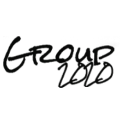We investigate multi-agent navigation tasks, where multiple agents need to reach initially unassigned goals in a limited time. Classical planning-based methods suffer from expensive computation overhead at each step and offer limited expressiveness for complex cooperation strategies. In contrast, reinforcement learning (RL) has recently become a popular approach for addressing this issue. However, RL struggles with low data efficiency and cooperation when directly exploring (nearly) optimal policies in a large exploration space, especially with an increased number of agents(e.g., 10+ agents) or in complex environments (e.g., 3-D simulators). In this paper, we propose the Multi-Agent Scalable Graph-based Planner (MASP), a goal-conditioned hierarchical planner for navigation tasks with a substantial number of agents in the decentralized setting. MASP employs a hierarchical framework to reduce space complexity by decomposing a large exploration space into multiple goal-conditioned subspaces, where a high-level policy assigns agents goals, and a low-level policy navigates agents toward designated goals. For agent cooperation and the adaptation to varying team sizes, we model agents and goals as graphs to better capture their relationship. The high-level policy, the Goal Matcher, leverages a graph-based Self-Encoder and Cross-Encoder to optimize goal assignment by updating the agent and the goal graphs. The low-level policy, the Coordinated Action Executor, introduces the Group Information Fusion to facilitate group division and extract agent relationships across groups, enhancing training efficiency for agent cooperation. The results demonstrate that MASP outperforms RL and planning-based baselines in task efficiency.
翻译:暂无翻译



